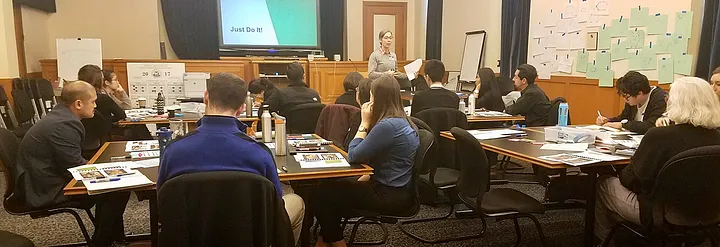San Francisco, California, USA
San Francisco: Building Stronger Neighborhoods and a Data-Fluent City Hall.
Project Type:
Community Engagement, Communications, Environment, Health & Wellness, High-Performing Government
At a Glance
Since becoming one of the first local governments in the country to pass an open data policy in 2009, the City has continued to build on its commitment to transparency and putting data at the core of decision-making.
Surveyed 500 residents in five neighborhoods to determine and address the top concerns that have the greatest impact on the residents’ quality of life.
Implemented data skillbuilding courses for City staff resulting in each saving an average of 1.4 hours weekly — translating into $1.7 million in savings annually for the City.
San Francisco’s Fix-It Efforts
Residents of San Francisco’s Glen Park neighborhood gathered one evening with city staff outside the local BART train station in preparation for a Fix-It walk. The group would spend the next two hours walking around, noting problems such as street light outages or traffic congestion and developing a plan for repairs.
Judy, a Glen Park resident for 30 years, says she joined the Fix-It effort so that she could “get involved before the changes are implemented, rather than complaining about them after the fact.” That’s exactly what Fix-It Director Sandra Zuniga wants. “Doing fixes the community doesn’t want me to do is a waste of my time,” she explains.

The late Mayor Ed Lee launched the Fix-It initiative in May 2016 as part of his Safe and Clean Neighborhoods Promise to improve the quality of life in San Francisco. Making the city a better place to live and providing more efficient government services are part of his vision for San Francisco’s open data strategy as well. Since passing an open data policy in 2009 — becoming one of the first local governments in the country to do so — the City has continued to build on its commitment to transparency and putting data at the core of decision-making.
Fix-It is a great example of how data can ensure that cities are targeting the neediest communities. Initially, Fix-It was rolled out in five pilot neighborhoods where the City received a lot of complaints. Before Mayor Lee decided to expand the program into 20 more neighborhoods, the team surveyed some 500 residents in five languages in five neighborhoods to determine the top concerns that have the greatest impact on residents’ quality of life. The team then worked with the Mayor’s Office of Civic Innovation to map data from 311 and the San Francisco Police Department to visualize where those three concerns were most concentrated, leading to the identification of new target neighborhoods.

In City Hall, Chief Data Officer Joy Bonaguro directs efforts to ensure that the broadest, best use of data is embedded in the City’s culture through DataSF, a team responsible for maintaining the City’s open data portal and supporting staff with data. DataSF offers a four-month engagement to departments that identify a challenge ripe for data science. Receiving the assistance is a two-way street, however, so each department must remain committed to a service change, if that’s where the data leads. The first cohort has been tackling issues that include keeping WIC-eligible women and their infants enrolled in a nutrition program and increasing eviction prevention.
Since 2014, Data Academy, a partnership between DataSF and the Controller’s Performance Unit, has grown from a handful of workshops on data visualization to nearly 20 courses on behavioral economics, information design, lean process mapping, and more. The goal, according to Bonaguro, is to “empower staff with the data skills that help them thrive.” In turn, they’re helping the City thrive as well. By March 2017, more than 1,700 city staff had attended training, and by taking what they’ve learned back to their teams, they are each saving an average of 1.4 hours weekly — translating into $1.7 million in savings annually for the City.
The City’s Performance Director, Peg Stevenson, notes that increasing staff capacity has prompted employees to help each other to problem-solve. There’s another ripple effect as well: policymakers are more frequently asking for data, and there are clear benefits for residents, too.
As the City continues to apply data to efforts promoting “real-time democracy on the ground,” as Bonaguro describes Fix-It, residents like Judy are showing up and demanding it.
She may just be starting to see the presence of Fix-It in her neighborhood, but Judy already seems to have a hunch that the effect of small fixes can really add up.
“It’s these little things that make your life good or bad,” she says.
Read more about San Francisco’s data journey here.
“Data helps people better understand what they should be expecting from the government.”